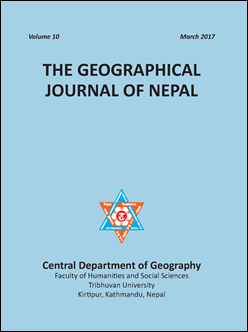Tourism development and economic and socio-cultural consequences in Everest Region
DOI:
https://doi.org/10.3126/gjn.v10i0.17392Keywords:
Everest Region, Sherpa, trekking and mountaineering tourism, consequences, hotel and lodgesAbstract
Being a mountainous country, Nepal is one of the destinations of tourist. Everest Region is one of the major destination trekking and mountaineering tourism and ranks second after Annapurna Region in term of number of tourists visiting different regions of Nepal. The number of tourist visiting this region increased from only 1406 in 1971/72 to 37124 in 2014. Such a growth of tourism has several socio-economic and cultural consequences. This paper discusses the consequences of tourism in Everest Region. Informations were collected along the trekking routes from Lukla to Dinboche through focus group discussion, key informant interview and tourism business survey. The results indicate that the number of hotels and lodges in many settlements along the trekking route has increased tremendously. The main base of economic life of Sherpa community has been changed from agro-pastoralism to tourism based business. The level of employment and income of local people has improved. However, tourism has undermined Sherpa culture by introducing new values and lifestyles influencing from westerners, eroded the central role of religion and traditional value in Sherpa community. For the younger generation the tourist and their norms of behavior and patterns of consumption can be seductive. This is the symptom of losing of cultural value of Sherpa community and world identity of Sherpa in the future.
The Geographical Journal of Nepal Vol. 10: 89-104, 2017
Downloads
Downloads
Published
How to Cite
Issue
Section
License
© Authors




